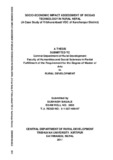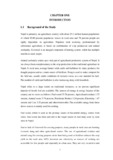Please use this identifier to cite or link to this item:
https://elibrary.tucl.edu.np/handle/123456789/3387| Title: | Socio-Economic Impact Assessment of Biogas Technology in Rural Nepal (A Case Study of Tribhuvanbasti VDC of Kanchanpur District) |
| Authors: | Bagale, Subhash |
| Keywords: | Socio economic;Technology |
| Issue Date: | 2011 |
| Publisher: | Central Departmental of Rural Development |
| Institute Name: | Central Department of Rural Development |
| Level: | Masters |
| Abstract: | The study was basically conducted to know the impact of biogas Technology in Rural Nepal Tribhuwanbasti VDC of Kanchanpur district which is in rural Far Western Development region is taken as a study area where there is a great probability of implementing biogas technology. In the study area there are 200 biogas plants among them 30 households (15 percentage) having biogas plants were taken as sample through random sampling process. In the process of collecting data, primary as well as secondary sources are used. Household survey along with designed questionnaire, focus group discussion with designed questionnaire and observation through check list are used to collect primary data and data from CBS (2002), District Profile Kanchanpur (2062 BS), GGC and BSP are used as secondary data. Mainly tabulation of data is done to organize compare and analyze the collected data. From the analysis of quantitative and qualitative data; the impact of biogas plant in rural areas found to be positive and environment friendly. Though the biogas technology had positive impact, its process of developing is found to be very slow. So to develop them some effective actions should be taken. From the analysis of collected data, the biogas plant holders were mostly Brahmins (63.34 percentage) and then respectively Chhetries 20 percentage and Gurungs were the least 3.34 percentage. Most of the respondents were related to agriculture (60 percentage). The respondents having 5 to 7 members in their family were about 53.34 percentage. About 43 percentage of the respondents had land above 30 kattha and only 10 percentage of the respondents had below 10 kattha. Only two sizes (6 m and 8m ) of biogas plant were found in the study area and biogas plant sized 6 m was found to be popular in the study area. The main reason for installing biogas was easy and smokeless cooking. Most of the respondents kept buffaloes (90 percentage) as source of dung. In an average about 3.5 hours per day was saved due to the installation of biogas and the saved time was mostly used in household works by 60 percentage respondents. 70 percentage respondents reported that there seemed to be the decrease in prevalence of mosquito after the installation of biogas plant. From the overall study, biogas technologies were found to be very useful to the household works, to keep the environment balanced, to minimize smoke caused disease, to minimize the rate of deforestation and each to increase the agricultural production and to assist the sustainable development. So biogas technologies should be developed as alternative source of energy in rural areas and they should be paid attention from GON, I/NGO’s, Community and Private Sector. |
| URI: | http://elibrary.tucl.edu.np/handle/123456789/3387 |
| Appears in Collections: | Rural Development |
Files in This Item:
| File | Description | Size | Format | |
|---|---|---|---|---|
| Cover.pdf | 39.57 kB | Adobe PDF |  View/Open | |
| Chapter.pdf | 254.3 kB | Adobe PDF |  View/Open |
Items in DSpace are protected by copyright, with all rights reserved, unless otherwise indicated.
